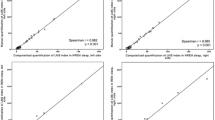Abstract
Objective
Current standard guidelines for scoring periodic leg movements (PLM) define the start and end of a movement but fail to explicitly specify the movement morphology necessary to classify an EMG event as a PLM, rather than some other muscle event. This is currently left to the expert visual scorer to determine. This study aimed to define this morphology to provide a consistent standard for visual scoring and to improve automatic periodic leg movements in sleep scoring.
Methods
A review of expert PLM scoring produced a hypothesized morphology criterion: a window of high EMG activity within the movement lasting at least 0.5 s. Two diverse expert visual scorers were independently presented with images of EMG tracings from candidate leg movements (CLM) that either passed or failed this requirement (aka “full” or “empty” movements, respectively), and indicated whether each should be scored as CLM. The 0.5-s window was compared with alternatives of 0.25 and 0.75 windows.
Results
Expert scorers on average identified 94 % of “full” movements as CLM in contrast to only 8.5 % of “empty” movements. The proposed minimum window of 0.5 s also resulted in the highest agreement between visual scorers and between scorers and an automatic program.
Conclusion
An added criterion requiring 0.5 s of high EMG activity within a valid CLM improves the accuracy of automatic scoring algorithms in relation to the gold standard of expert visual scorers. Our results suggest that this rule is an accurate representation of the morphology feature used by experts. This new rule has the potential to improve consistency and accuracy of visual and automatic scoring of PLM.




Similar content being viewed by others
References
Symonds CP (1953) Nocturnal myoclonus. J Neurol Neurosurg Psychiatry 16:166–171
Coleman RM, Pollak CP, Weitzman ED (1980) Periodic movements in sleep (nocturnal myoclonus): relation to sleep disorders. Ann Neurol 8:416–421. doi:10.1002/ana.410080413
Provini F, Vetrugno R, Meletti S, et al. (2001) Motor pattern of periodic limb movements during sleep. Neurology 57:300–304
Coleman RM, Pollack CP, Weitzman ED (1978) Periodic nocturnal myoclonus in a wide variety of sleep-wake disorders. Trans Am Neurol Assoc 103:230–233
Zucconi M, Ferri R, Allen R, et al. (2006) The official World Association of Sleep Medicine (WASM) standards for recording and scoring periodic leg movements in sleep (PLMS) and wakefulness (PLMW) developed in collaboration with a task force from the International Restless Legs Syndrome Study Group. Sleep Med 7:175–183. doi:10.1016/j.sleep.2006.01.001
Sforza E, Johannes M, Claudio B (2005) The PAM-RL ambulatory device for detection of periodic leg movements: a validation study. Sleep Med 6:407–413. doi:10.1016/j.sleep.2005.01.004
Gschliesser V, Frauscher B, Brandauer E, et al. (2009) PLM detection by actigraphy compared to polysomnography: a validation and comparison of two actigraphs. Sleep Med 10:306–311. doi:10.1016/j.sleep.2008.03.015
Berry R, Brooks R, Gamaldo C, et al (2015) The AASM Manual for the Scoring of Sleep and Associated Events. Rules, Terminology and Technical Specifications, Version 2.2. Darien, IL
Ferri R, Zucconi M, Manconi M, et al. (2005) Computer-assisted detection of nocturnal leg motor activity in patients with restless legs syndrome and periodic leg movements during sleep. Sleep 28:998–1004
Huang AS, Skeba P, Yang MS, et al (2015) MATPLM1, A MATLAB script for scoring of periodic limb movements: preliminary validation with visual scoring. Sleep Med. doi: 10.1016/j.sleep.2015.03.008
Frauscher B, Kunz A, Brandauer E, et al (2011) Fragmentary myoclonus in sleep revisited: a polysomnographic study in patients. Sleep Med 12:410–5. doi: 10.1016/j.sleep.2010.08.016
Acknowledgments
Sleep data acquisition and scoring were provided by The Center for Interdisciplinary Sleep Research and Education (CISRE) at Johns Hopkins University.
Author information
Authors and Affiliations
Corresponding author
Ethics declarations
Funding
This study was supported in part by a grant from the National Institute for Neurological Diseases and Stroke number NS075184. The sponsor had no role in the design or conduct of this research.
Conflict of interest
All authors certify that they have no affiliations with or involvement in any organization or entity with any financial interest (such as honoraria; educational grants; participation in speakers bureaus; membership, employment, consultancies, stock ownership, or other equity interest; and expert testimony or patent-licensing arrangements), or non-financial interest (such as personal or professional relationships, affiliations, knowledge or beliefs) in the subject matter or materials discussed in this manuscript.
Ethical approval
All procedures performed in studies involving human participants were in accordance with the ethical standards of the institutional and/or national research committee and with the 1964 Helsinki declaration and its later amendments or comparable ethical standards.
Informed consent
Informed consent was obtained from all individual participants included in the study.
Electronic supplementary material
Supplementary Figure 1
The region in red represents an LM as scored by strict WASM standards: it rises above the low threshold (roughly 7 microvolts if one zooms close enough into the picture) and does not remain below that threshold for 0.5 s until the end of the red region. The event is roughly 0.8 s long. Neither of our expert scorers would consider such a short spike (< 0.2 s), followed by such low (but high enough) activity as a legitimate LM, based on their experience. This movement fails our proposed morphology test, using the median window of 0.5 s, but a similar test using the mean accepts this movement. In general, the mean is too affected by extreme values, to exclude short bursts of extremely high energy (which could be anything from fragmentary myoclonus to EKG interference) unrelated to LM. (JPEG 24 kb)
Rights and permissions
About this article
Cite this article
Skeba, P., Fulda, S., Hiranniramol, K. et al. Defining morphology of periodic leg movements in sleep: an evidence-based definition of a minimum window of sustained activity. Sleep Breath 20, 1293–1299 (2016). https://doi.org/10.1007/s11325-016-1404-2
Received:
Revised:
Accepted:
Published:
Issue Date:
DOI: https://doi.org/10.1007/s11325-016-1404-2




